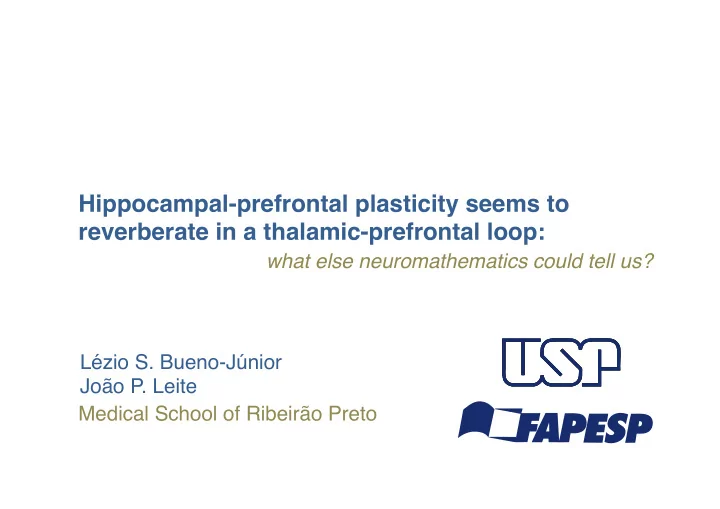

Hippocampal-prefrontal plasticity seems to reverberate in a thalamic-prefrontal loop: what else neuromathematics could tell us? Lézio S. Bueno-Júnior João P. Leite Medical School of Ribeirão Preto
1/5 First, the structure: a particular neural circuit. Then, its ( hypothetical ) function... ...from a phenomenological perspective. Lastly, its mathematical exploration... ...and extrapolation.
1/5 Then, its ( hypothetical ) function... ...from a phenomenological perspective.
1/5 Lastly, its mathematical exploration... ...and extrapolation.
2/5 Bueno-Júnior et al. (2012) – PLoS One v. 7 Lopes Aguiar et al. (2013) – Neuropharmacology v. 65
2/5 Hippocampus Neocortex Thalamus
2/5 CA1/ subiculum Prefrontal cortex Limbic thalamus
2/5 Slow-wave sleep or deep anesthesia CA1/ subiculum Prefrontal cortex Limbic thalamus
2/5 REM sleep or the awake state CA1/ subiculum Prefrontal cortex Limbic thalamus
2/5 REM sleep or the awake state CA1/ subiculum Prefrontal cortex What now? Limbic thalamus
3/5 CA1/ subiculum Rec Prefrontal cortex Limbic Rec thalamus
3/5 Rostral Caudal PF cortex recording CA1/sub MD thalamus stimulation recording HFS Perfusion Baseline Post-HFS monitoring 30 min 120 min 80 ms ... 10 s
4/5 Some descriptive statistics
4/5 PF cortex MD thalamus 30 30 60 60 90 90 Recording length (min) 120 120 150 150 1 0.4 30 30 0.6 60 60 0.2 90 90 0.2 0 120 120 -0.2 -0.2 150 150 Baseline 0.2 Firing rate (Z score) 60 μV Early monit 0.8 70 μV Late monit 0.1 1,19 Hz 3,09 Hz 0.4 1 ms 1 ms 0 800 spikes 40 spikes 0 -0.1 -0.2 -0.4 ISI 200 ms ISI 200 ms -0.2 0 0.2 0.4 0.6 0.8 1.0 -0.2 0 0.2 0.4 0.6 0.8 1.0 Perievent time (s) Perievent time (s)
4/5 PF cortex MD thalamus 30 30 60 60 90 90 Recording length (min) 120 120 150 150 1 0.4 30 Only two neurons!? 30 0.6 60 Some descriptive statistics 60 0.2 90 90 0.2 0 120 120 -0.2 -0.2 150 150 Baseline 0.2 Firing rate (Z score) 60 μV Early monit 0.8 70 μV Late monit 0.1 1,19 Hz 3,09 Hz 0.4 1 ms 1 ms 0 800 spikes 40 spikes 0 -0.1 -0.2 -0.4 ISI 200 ms ISI 200 ms -0.2 0 0.2 0.4 0.6 0.8 1.0 -0.2 0 0.2 0.4 0.6 0.8 1.0 Perievent time (s) Perievent time (s)
4/5
4/5 MD thalamic neurons did respond to hippocampal pulses: phasic excitation then transient inhibition HFS-favored PF cortical responses were subtler and slower: inhibition then excitation HFS-dependent
4/5 PF cortex MD thalamus Recording length (min) 30 10 5 60 0 90 -5 120 -10 150 Baseline 0,3 Early monit Late monit 0,2 Voltage (mV) 0,1 0 -0,1 nº 1 -0,2 fPSP nº 1 nº 2 nº 2 -20 20 60 100 140 -20 20 60 100 140 Perievent time (s)
5/5 CA1/ subiculum Prefrontal cortex Limbic thalamus
5/5 Non-motor (i.e., cognitive) efference copies...? ...modulated by the CA1/ sleep-wake cycle? subiculum Prefrontal cortex Do they have something to Limbic do with working memory…? thalamus …or the spread of epileptic seizures?
5/5 Hippocampus Neocortex Thalamus
5/5 Sleep-wake? Hippocampus Neocortex Thalamus Working memory? S u b c l i n i c a l p a r o x y s m s ?
Recommend
More recommend